Spring 源码学习 16:单例 Bean 创建
前言
在 finishBeanFactoryInitialization 中介绍了创建 Bean 的流程大概流程,这里进入单例 Bean 的创建过程。
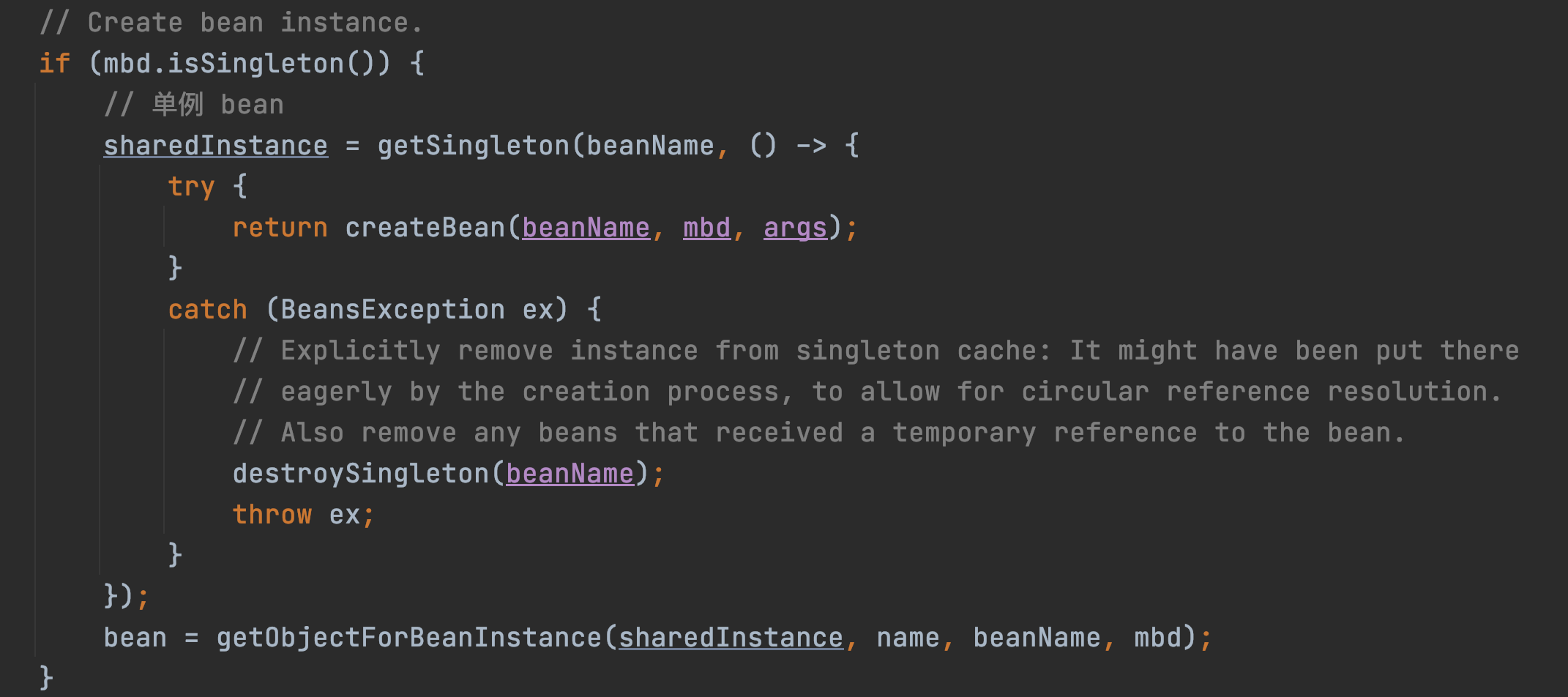
这里主要分为三个部分创建单例 Bean
- getSingleton
- createBean
- getObjectForBeanInstance
下面进入源码:
getSingleton
public Object getSingleton(String beanName, ObjectFactory<?> singletonFactory) {
Assert.notNull(beanName, "Bean name must not be null");
// 加锁
synchronized (this.singletonObjects) {
// 检查 singletonObjects 缓存中是否有
Object singletonObject = this.singletonObjects.get(beanName);
if (singletonObject == null) {
// 检查是否在执行销毁
if (this.singletonsCurrentlyInDestruction) {
throw new BeanCreationNotAllowedException(beanName,
"Singleton bean creation not allowed while singletons of this factory are in destruction " +
"(Do not request a bean from a BeanFactory in a destroy method implementation!)");
}
if (logger.isDebugEnabled()) {
logger.debug("Creating shared instance of singleton bean '" + beanName + "'");
}
// 将 Bean 添加到 singletonsCurrentlyInCreation 集合中, 表示正在创建
beforeSingletonCreation(beanName);
boolean newSingleton = false;
boolean recordSuppressedExceptions = (this.suppressedExceptions == null);
if (recordSuppressedExceptions) {
this.suppressedExceptions = new LinkedHashSet<>();
}
try {
// 调用工厂方法
// 也就是调用 createBean(beanName, mbd, args)
singletonObject = singletonFactory.getObject();
newSingleton = true;
}
catch (IllegalStateException ex) {
// Has the singleton object implicitly appeared in the meantime ->
// if yes, proceed with it since the exception indicates that state.
singletonObject = this.singletonObjects.get(beanName);
if (singletonObject == null) {
throw ex;
}
}
catch (BeanCreationException ex) {
if (recordSuppressedExceptions) {
for (Exception suppressedException : this.suppressedExceptions) {
ex.addRelatedCause(suppressedException);
}
}
throw ex;
}
finally {
if (recordSuppressedExceptions) {
this.suppressedExceptions = null;
}
// 创建成功, 从 singletonsCurrentlyInCreation 移除
afterSingletonCreation(beanName);
}
if (newSingleton) {
// 将给定的单例对象添加到该工厂的单例缓存中
// this.singletonObjects.put(beanName, singletonObject);
// this.singletonFactories.remove(beanName);
// this.earlySingletonObjects.remove(beanName);
// this.registeredSingletons.add(beanName);
addSingleton(beanName, singletonObject);
}
}
return singletonObject;
}
}
返回以给定名称注册的(原始)单例对象,如果尚未注册,则创建并注册一个新对象。
这一块一共可以拆成三部分来理解:
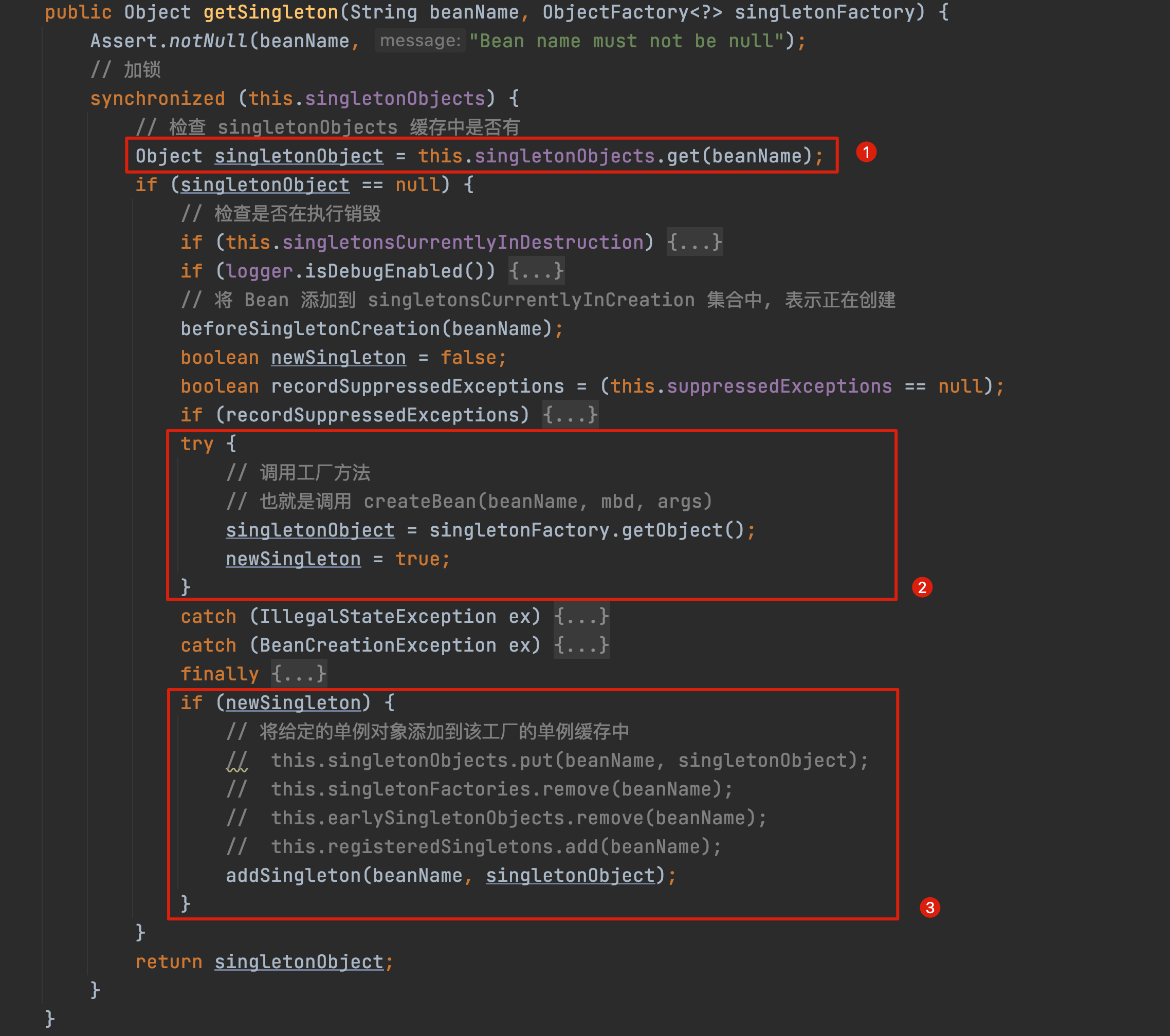
1. 从缓存中获取 singletonObjects
singletonObject 是什么?
/** Cache of singleton objects: bean name to bean instance. */
private final Map<String, Object> singletonObjects = new ConcurrentHashMap<>(256);
singletonObjects 是一个 ConcurrentHashMap, 用来缓存单例对象的实例。
2. 创建 singletonObject
在从缓存中没有获取到 singletonObject ,创建新的对象
singletonObject = singletonFactory.getObject();
这一步其实就是调用外边的 createBean(beanName, mbd, args) 方法,这是一个工厂方法。 通过 createBean 方法,会创建一个新的 singletonObject。
3. 将创建的 singletonObject 添加到缓存中
protected void addSingleton(String beanName, Object singletonObject) {
synchronized (this.singletonObjects) {
this.singletonObjects.put(beanName, singletonObject);
this.singletonFactories.remove(beanName);
this.earlySingletonObjects.remove(beanName);
// 已经成功创建的单例
this.registeredSingletons.add(beanName);
}
}
这一步涉及到三个缓存,以及一个成功创建的单例列表。
/** Cache of singleton objects: bean name to bean instance. */
/** 缓存单例对象, K-V -> BeanName - Bean 实例 */
private final Map<String, Object> singletonObjects = new ConcurrentHashMap<>(256);
/** Cache of singleton factories: bean name to ObjectFactory. */
/** 缓存 Bean 工厂 */
private final Map<String, ObjectFactory<?>> singletonFactories = new HashMap<>(16);
/** Cache of early singleton objects: bean name to bean instance. */
/** 缓存早期单例对象 */
private final Map<String, Object> earlySingletonObjects = new ConcurrentHashMap<>(16);
/** Set of registered singletons, containing the bean names in registration order. */
/** 已注册的单例列表,按注册顺序保存 BeanName。 */
private final Set<String> registeredSingletons = new LinkedHashSet<>(256);
将创建的单例对象,添加到单例缓存中,同时将工厂缓存以及早期单例对象缓存中的对应对象删除。
createBean
protected Object createBean(String beanName, RootBeanDefinition mbd, @Nullable Object[] args)
throws BeanCreationException {
if (logger.isTraceEnabled()) {
logger.trace("Creating instance of bean '" + beanName + "'");
}
RootBeanDefinition mbdToUse = mbd;
// Make sure bean class is actually resolved at this point, and
// clone the bean definition in case of a dynamically resolved Class
// which cannot be stored in the shared merged bean definition.
// 获取真实的类型
Class<?> resolvedClass = resolveBeanClass(mbd, beanName);
if (resolvedClass != null && !mbd.hasBeanClass() && mbd.getBeanClassName() != null) {
// 创建新的 mbd 防止 其他线程修改
mbdToUse = new RootBeanDefinition(mbd);
mbdToUse.setBeanClass(resolvedClass);
}
// Prepare method overrides.
try {
// 验证并准备为此bean定义的方法替代。 检查是否存在具有指定名称的方法。
mbdToUse.prepareMethodOverrides();
}
catch (BeanDefinitionValidationException ex) {
throw new BeanDefinitionStoreException(mbdToUse.getResourceDescription(),
beanName, "Validation of method overrides failed", ex);
}
try {
// Give BeanPostProcessors a chance to return a proxy instead of the target bean instance.
// 应用实例化之前的后处理器,以解决指定的bean是否存在实例化快捷方式。
// InstantiationAwareBeanPostProcessor 后置处理器
// postProcessBeforeInstantiation 方法可能会已经实例化 Bean
Object bean = resolveBeforeInstantiation(beanName, mbdToUse);
if (bean != null) {
return bean;
}
}
catch (Throwable ex) {
throw new BeanCreationException(mbdToUse.getResourceDescription(), beanName,
"BeanPostProcessor before instantiation of bean failed", ex);
}
try {
// 实例化 Bean
Object beanInstance = doCreateBean(beanName, mbdToUse, args);
if (logger.isTraceEnabled()) {
logger.trace("Finished creating instance of bean '" + beanName + "'");
}
return beanInstance;
}
catch (BeanCreationException | ImplicitlyAppearedSingletonException ex) {
// A previously detected exception with proper bean creation context already,
// or illegal singleton state to be communicated up to DefaultSingletonBeanRegistry.
throw ex;
}
catch (Throwable ex) {
throw new BeanCreationException(
mbdToUse.getResourceDescription(), beanName, "Unexpected exception during bean creation", ex);
}
}
这个方法中涉及到:创建 Bean 实例 , 填充 Bean , 应用 PostProcessor。
其中实例化 Bean 是在 doCreateBean 中。现在重点看一下 doCreateBean 方法。
doCreateBean
protected Object doCreateBean(String beanName, RootBeanDefinition mbd, @Nullable Object[] args)
throws BeanCreationException {
// Instantiate the bean.
// Bean 的 对象包装
BeanWrapper instanceWrapper = null;
if (mbd.isSingleton()) {
// 从缓存中获取
instanceWrapper = this.factoryBeanInstanceCache.remove(beanName);
}
if (instanceWrapper == null) {
// 缓存中获取不到则直接创建, 这里创建的 BeanInstance !!!
instanceWrapper = createBeanInstance(beanName, mbd, args);
}
// 获取 Bean 实例以及类型
Object bean = instanceWrapper.getWrappedInstance();
Class<?> beanType = instanceWrapper.getWrappedClass();
if (beanType != NullBean.class) {
mbd.resolvedTargetType = beanType;
}
// Allow post-processors to modify the merged bean definition.
synchronized (mbd.postProcessingLock) {
if (!mbd.postProcessed) {
try {
// 如果允许修改 mbd
// 调用 MergedBeanDefinitionPostProcessor 后置处理器的
// postProcessMergedBeanDefinition(mbd, beanType, beanName);
applyMergedBeanDefinitionPostProcessors(mbd, beanType, beanName);
}
catch (Throwable ex) {
throw new BeanCreationException(mbd.getResourceDescription(), beanName,
"Post-processing of merged bean definition failed", ex);
}
mbd.postProcessed = true;
}
}
// Eagerly cache singletons to be able to resolve circular references
// even when triggered by lifecycle interfaces like BeanFactoryAware.
// mbd 是单例 且 允许循环引用, (默认 true) 且在创建
boolean earlySingletonExposure = (mbd.isSingleton() && this.allowCircularReferences &&
isSingletonCurrentlyInCreation(beanName));
if (earlySingletonExposure) {
if (logger.isTraceEnabled()) {
logger.trace("Eagerly caching bean '" + beanName +
"' to allow for resolving potential circular references");
}
// 先获取 之前的 Bean 的引用, 从 beanPostProcessorCache 中 获取 SmartInstantiationAwareBeanPostProcessor
// 然后从 SmartInstantiationAwareBeanPostProcessor#getEarlyBeanReference 获取之前的引用
addSingletonFactory(beanName, () -> getEarlyBeanReference(beanName, mbd, bean));
}
// Initialize the bean instance.
Object exposedObject = bean;
try {
// 属性赋值
populateBean(beanName, mbd, instanceWrapper);
// 执行 init 方法
exposedObject = initializeBean(beanName, exposedObject, mbd);
}
catch (Throwable ex) {
if (ex instanceof BeanCreationException && beanName.equals(((BeanCreationException) ex).getBeanName())) {
throw (BeanCreationException) ex;
}
else {
throw new BeanCreationException(
mbd.getResourceDescription(), beanName, "Initialization of bean failed", ex);
}
}
// 这里允许循环依赖
if (earlySingletonExposure) {
// 获取早期的 Bean, 如果没有循环依赖 则获取不到
Object earlySingletonReference = getSingleton(beanName, false);
// 有循环依赖
if (earlySingletonReference != null) {
// 创建的是不是同一个,可能会有代理对象
if (exposedObject == bean) {
exposedObject = earlySingletonReference;
}
else if (!this.allowRawInjectionDespiteWrapping && hasDependentBean(beanName)) {
// 获取依赖的 Bean 并 循环放入到 actualDependentBeans
String[] dependentBeans = getDependentBeans(beanName);
Set<String> actualDependentBeans = new LinkedHashSet<>(dependentBeans.length);
for (String dependentBean : dependentBeans) {
if (!removeSingletonIfCreatedForTypeCheckOnly(dependentBean)) {
actualDependentBeans.add(dependentBean);
}
}
if (!actualDependentBeans.isEmpty()) {
throw new BeanCurrentlyInCreationException(beanName,
"Bean with name '" + beanName + "' has been injected into other beans [" +
StringUtils.collectionToCommaDelimitedString(actualDependentBeans) +
"] in its raw version as part of a circular reference, but has eventually been " +
"wrapped. This means that said other beans do not use the final version of the " +
"bean. This is often the result of over-eager type matching - consider using " +
"'getBeanNamesForType' with the 'allowEagerInit' flag turned off, for example.");
}
}
}
}
// Register bean as disposable.
try {
// 注册销毁方法
registerDisposableBeanIfNecessary(beanName, bean, mbd);
}
catch (BeanDefinitionValidationException ex) {
throw new BeanCreationException(
mbd.getResourceDescription(), beanName, "Invalid destruction signature", ex);
}
return exposedObject;
}
同样是代码很长很长!
分步骤阅读:

如果这个 Bean 是单例 Bean 且允许循环引用且在创建中,则说明在有循环引用。则调用:
addSingletonFactory(beanName, () -> getEarlyBeanReference(beanName, mbd, bean));
这一行代码涉及到两个方法,分别是 getEarlyBeanReference 和 addSingletonFactory
- getEarlyBeanReference

- addSingletonFactory
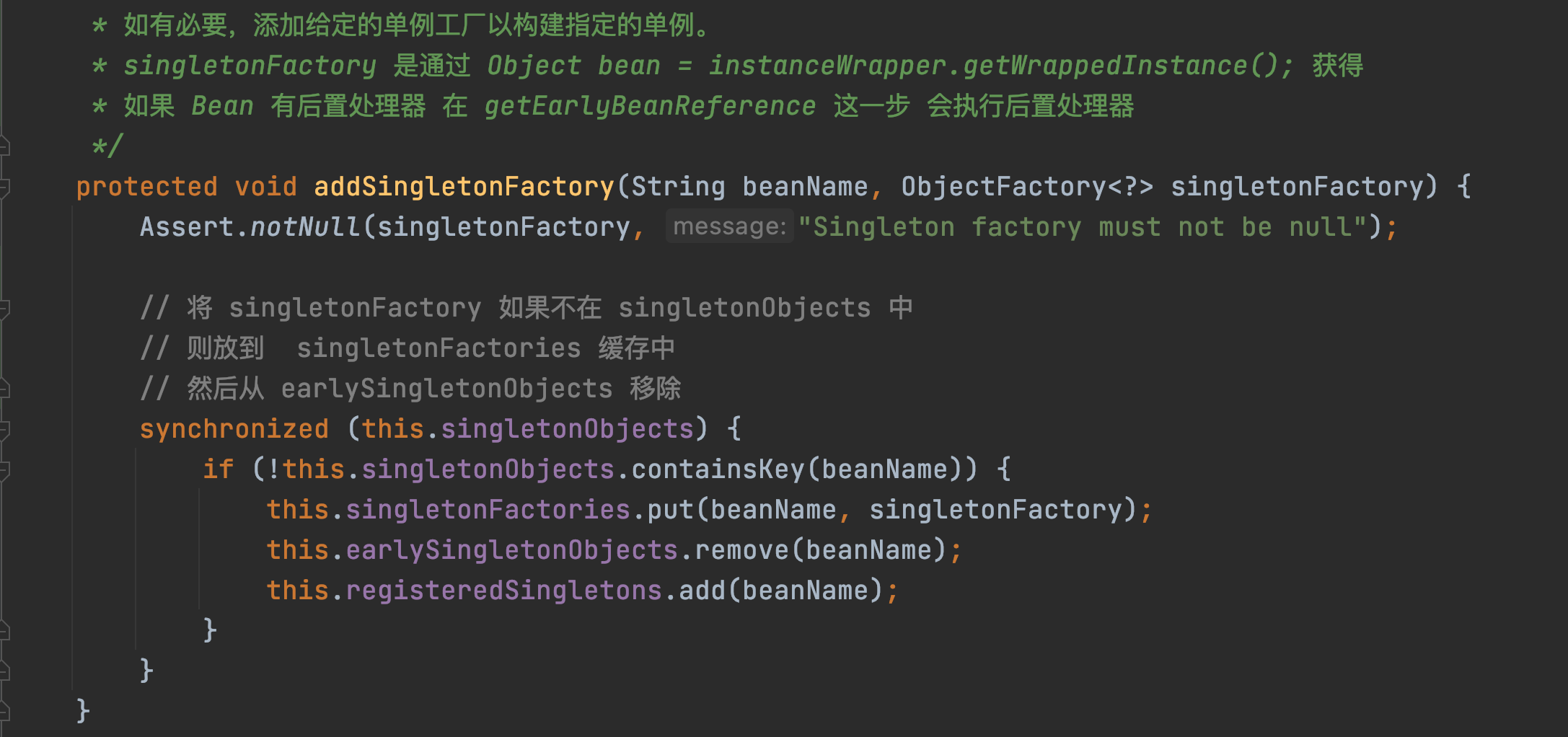
这一块可以看到将创建的一个单例对象的 singletonFactory 添加到了 singletonFactories 缓存中。
同时将 earlySingletonObjects 缓存中的单例对象移除。
那什么时候添加到 earlySingletonObjects 缓存中的呢?
这块可以参考 Spring 源码学习 15:finishBeanFactoryInitialization 在 getSingleton 方法中 put 进去的。
为了方便,我把这一小块代码也贴出来:
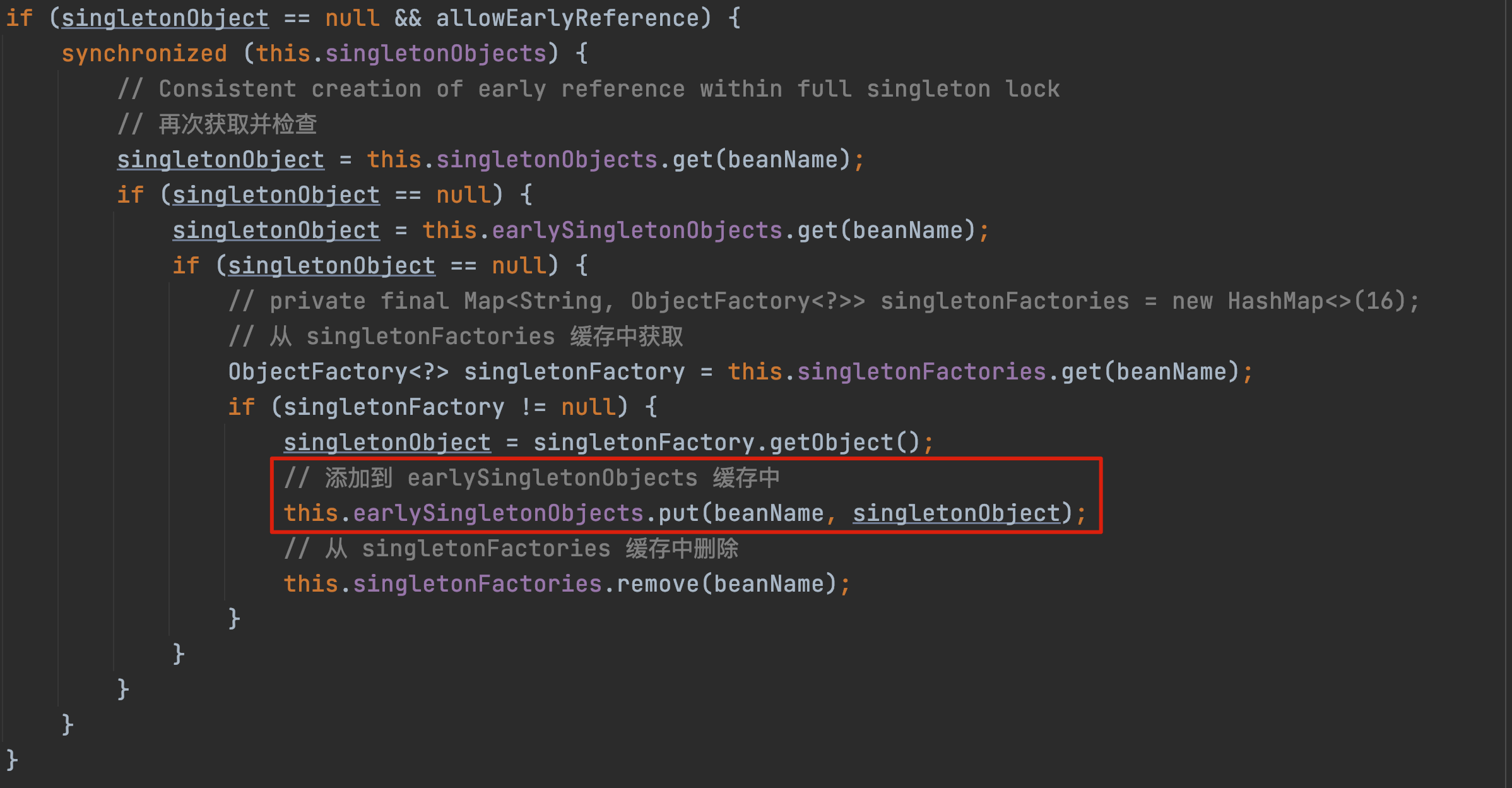
在这里将缓存从 singletonFactories 移到了 earlySingletonObjects。
Spring 的 Bean 实例化的时候用到的三级缓存其实是:
singletonObjects: 一级缓存,存储单例对象,Bean 已经实例化,初始化完成。
earlySingletonObjects: 二级缓存,存储 singletonObject,这个 Bean 实例化了,还没有初始化。
singletonFactories: 三级缓存,存储 singletonFactory
下面会初始化 Bean
这里关注重点关注下面一部分:

- populateBean
对 Bean 的属性进行赋值。
这块需要注意的是,在对属性进行赋值时,发现依赖了其他 Bean,就会去先创建其他 Bean。
我这边使用的注解 @Autowired 就会执行下面一部分:
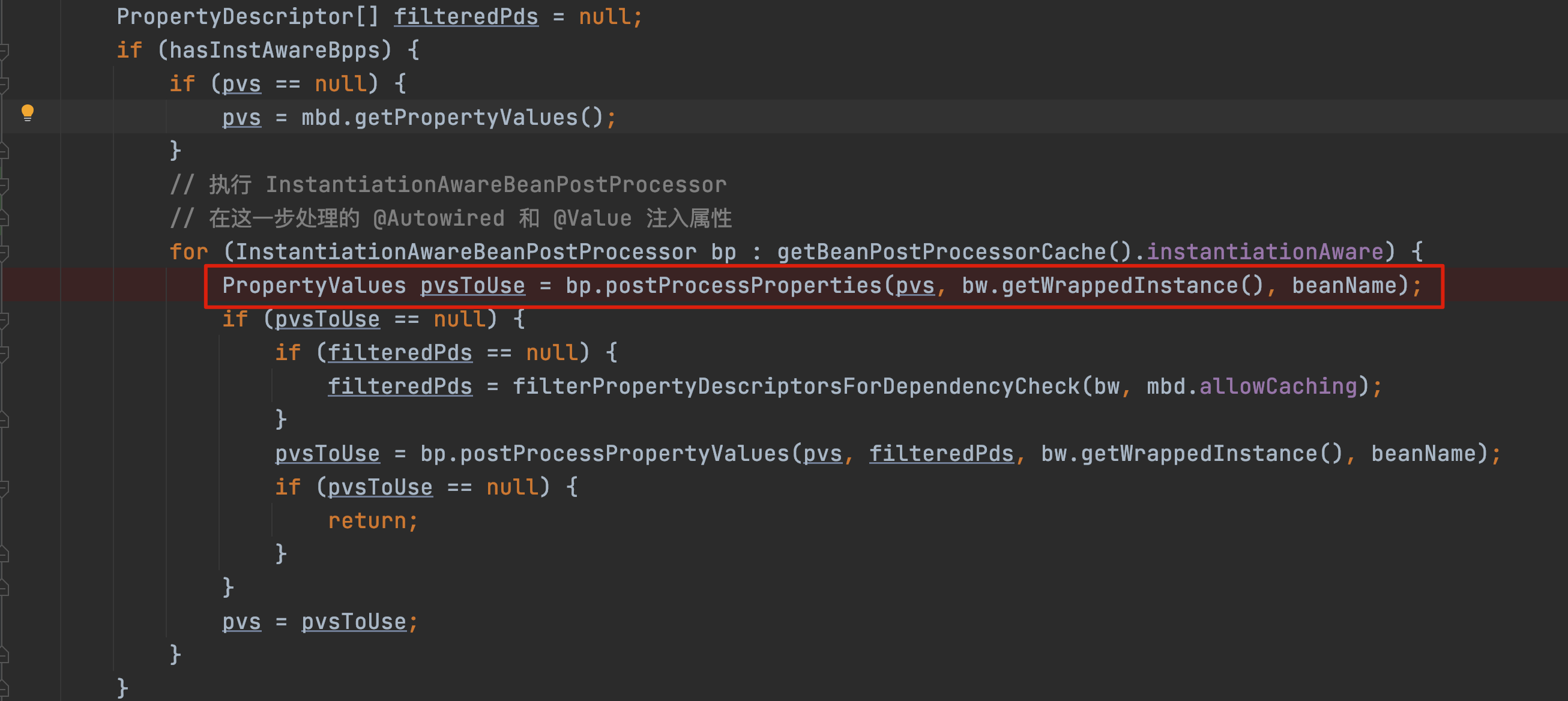
在这里解析属性的时候,就会去创建内部依赖的 Bean。
- initializeBean
getObjectForBeanInstance
获取给定bean实例的对象,如果是FactoryBean,则为bean实例本身或其创建的对象。
这一块逻辑相对比较简单,就是根据前面你创建的 beanInstance , 判断其类型,从而创建 Bean 实例。
总结
本文主要介绍了一个 单例 Bean 的创建,当然都是大块大块的源码,需要耐心的啃。
阅读完源码,基本上对循环依赖能有个详细的了解,知道 Spring 在初始化 Bean 的时候是使用三级缓存来处理循环依赖的额,而后面则会单独准备一篇文章对循环依赖做介绍。
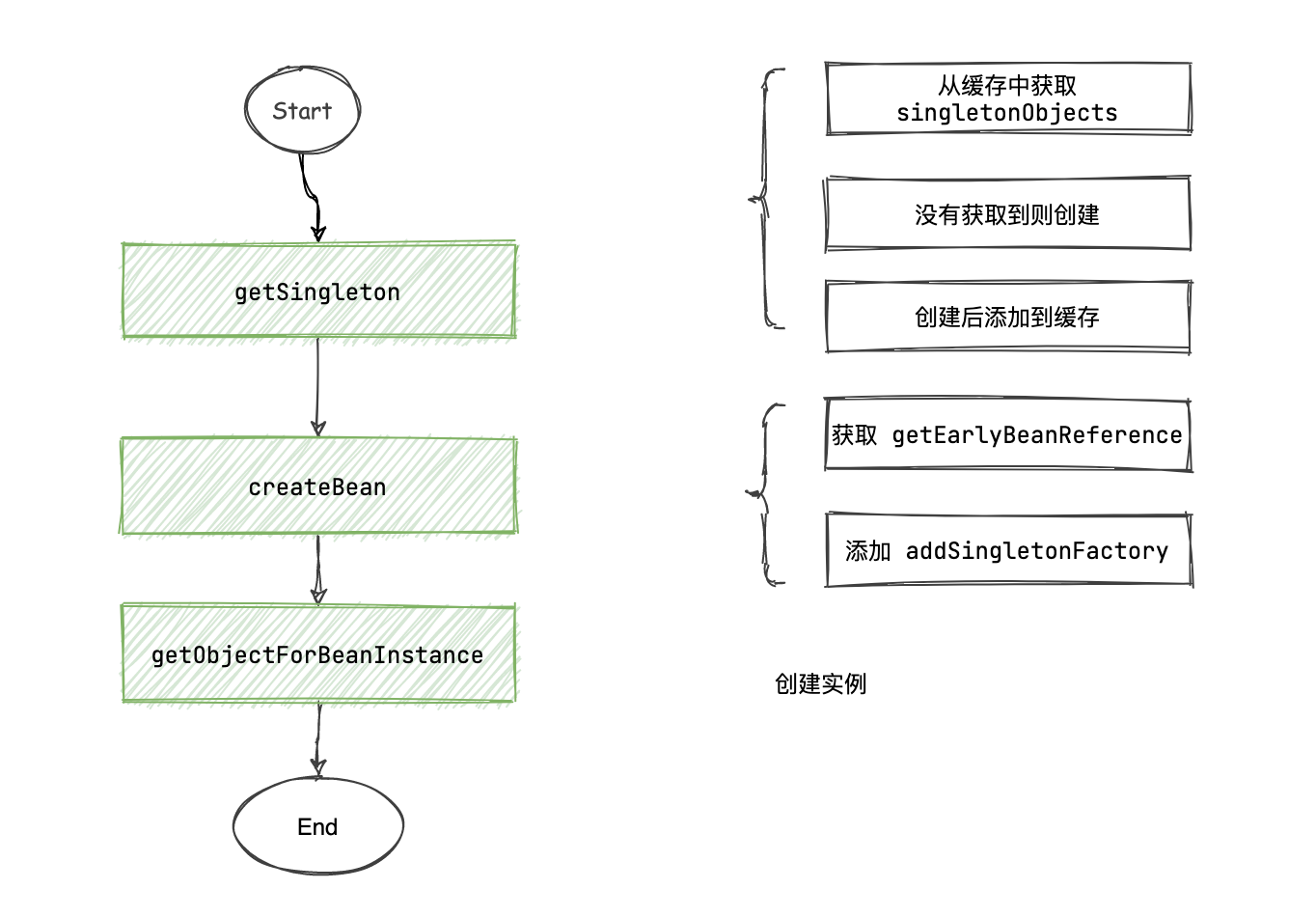


【推荐】国内首个AI IDE,深度理解中文开发场景,立即下载体验Trae
【推荐】凌霞软件回馈社区,携手博客园推出1Panel与Halo联合会员
【推荐】轻量又高性能的 SSH 工具 IShell:AI 加持,快人一步